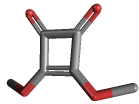|
DIMETHYL SQUARATE |
| Synonyms. Squaric acid dimethyl ester; 3,4-Dimethoxy-3-cyclobutene-1,2-dione; Dimethyl squarate; Dimethoxycyclobutenedione; |
|
|
| PRODUCT IDENTIFICATION | |
|
CAS RN |
5222-73-1 |
|
EINECS RN |
|
|
FORMULA |
(CH3O)2C4(=O)2 |
|
MOLE WEIGHT |
142.11 |
|
H.S CODE |
2914.50.5000 |
|
SMILES |
C1(=C(OC)C(C1=O)=O)OC |
|
CLASSIFICATION |
|
|
EXTRA NOTES |
|
|
|
| PHYSICAL AND CHEMICAL PROPERTIES | |
|
PHYSICAL STATE. |
white to off-white crystalline powder |
|
MELTING POINT |
55 ~ 57 C |
|
BOILING POINT |
286 C |
|
DENSITY |
|
|
SOLUBILITY IN WATER |
|
| SOLVENT SOLUBILITY |
|
|
VAPOR DENSITY |
|
|
log P(octanol-water) |
|
|
VAPOR PRESSURE |
|
|
AUTOIGNITION TEMP |
|
| pK |
|
|
REFRACTIVE INDEX |
|
|
FLASH POINT |
|
|
|
| STABILITY AND REACTIVITY | |
| STABILITY | Stable under normal conditions. |
|
INCOMPATIBLE MATERIALS |
Oxidizing agents |
| POLYMERIZATION |
Has not been reported |
|
NFPA RATINGS |
Health: 1, Flammability: 0, Reactivity: 0 |
|
|
| EXTERNAL LINKS & GENERAL DESCRIPTION |
|
USA.gov - Dimethyl squarate Wikipedia Linking - Squaric acid Google Scholar Search - Squaric acid dimethyl ester PubChem Compound Summary - Squaric acid dimethyl ester http://www.ncbi.nlm.nih.gov/ - Squaric acid dimethyl ester Material Safety Data Sheet - Squaric acid dimethyl ester http://www.sigmaaldrich.com/ |
|
|
| SALES SPECIFICATION | |
|
APPEARANCE |
white to off-white crystalline powder |
|
ASSAY |
99% min |
|
MELTING POINT |
55 ~ 57 C |
|
WATER |
0.5% max |
|
|
| TRANSPORT & REGULATORY INFORMATION | |
|
UN NO. |
|
| HAZARD CLASS |
|
| PACKING GROUP | |
|
|
| SAFETY INFORMATION | |
|
HAZARD OVERVIEW |
OSHA Hazards: Not known. GHS (Globally Harmonised System) Classification: Respiratory sensitization, Skin sensitization. May cause an allergic skin reaction. May cause allergy or asthma symptoms or breathing difficulties if inhaled. Potential Health Effects. Eye: May cause eye irritation. Skin: May cause skin irritation. Ingestion: May cause irritation of the digestive tract. Inhalation: May cause respiratory tract irritation. The toxicological properties of this substance have not been fully investigated. Chronic:No information found. |
| SIGNAL WORD | Danger |
|
PICTOGRAMS |
|
|
HAZARD STATEMENTS |
H317-H334 |
|
P STATEMENTS |
P261-P280-P342 + P311 |
| EC DIRECTIVES |
|
| HAZARD CODES |
|
|
RISK PHRASES |
42/43 |
|
SAFETY PHRASES |
22-24/25-26-36/37/39 |
|
|
| PACKING |
|
Preserve in light-resistant and well-closed containers |
|
|

